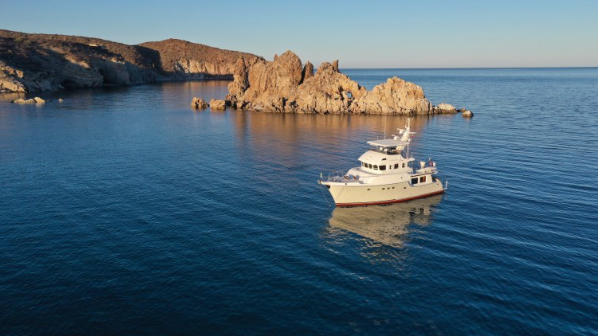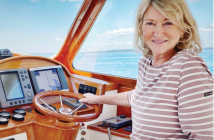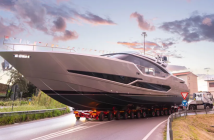One Baja Bash and 4,000 nm later, Red Rover, the well-traveled 2005 Nordhavn 55, is back home in the United States after cruising in Mexico both before and during the time of coronavirus.
Back in 2016, Kevin and Allison Jeffries, lifelong boaters, sold their house in Seattle and moved aboard Red Rover full time with their two shelter dogs, Zoe and Max. Their children were grown, and they’ve been cruising ever since.
Last October, the Jeffries cruised down to Mexico; they went as far south as the far side of Puerto Vallarta before heading back to the Loreto in the Sea of Cortez. Then the pandemic hit. The Jeffries, with many other cruising people, weren’t sure about what to do. Accurate information was hard to come by.
Allison wrote on their blog, comeonrover.com, that they got together with Gitana, another Nordhavn 55, and decided that they would cruise in tandem for a while. They didn’t want to create stress on the small communities they normally would visit, or become a burden to the Mexican healthcare system.
“Basically,” she wrote, “we created a bubble, and we stayed in it. We visited with other boaters from our dinghies, talked from our cockpits, we provisioned the heck out of the boat (via a grocery delivery service at the marina) before we left to head out to isolate, and we enjoyed the comfort of Red Rover, with just the two of us and the dogs.”
As the anchorages near Loreto became crowded with other boats, including many who had planned to cruise to the South Pacific, Red Rover and Gitana headed out on the Sea of Cortez. They spent a week at the top of Isla Carmen, exploring sea caves by dinghy, waiting for a weather window to head back home.
They also had a deadline: Their insurance said they had to be in Ensenada or north by July 1 to avoid the hurricane season.
They ended up at an anchorage between San Jose del Cabo and La Paz and then at 2 a.m. “we headed out to start our Baja Bash, rounding the point of the Baja peninsula and beginning the trek north.”
“The Baja Bash is a thing,” Allison wrote. “People talk about it. People ship their boats and hire captains to move their boats to avoid it. Basically, if you are heading north up the west coast of Baja you are heading straight into the prevailing winds and seas, which creates, you guessed it, a bashing movement on your boat…
“While we know our boat can handle a whole lot of ocean, and we have ourselves experienced some very large seas, we don’t WANT to bash.” They had time, they waited for a weather window.
After rounding the tip of Baja California, they had a 32-hour run to Magdalena Bay, where they had to stay a week waiting for another weather window. They couldn’t go ashore because of the pandemic, but local fishermen on pangas sold them fresh lobster and brought groceries. Before they left they transferred 100 gallons of water from Red Rover to a series of jugs on a panga with a family who said they were living in a fish camp that had no running water.
Then they had another 32-hour run north to Turtle Bay, where they ran into 6- to 8-foot swells inside the bay. They spent another week there waiting for a weather window, before finally leaving at 4 a.m. for a 47-hour run to San Diego.
They crossed the border at 1 a.m. only to hear on the VHF that the Navy was holding “high speed maneuvers” right in front of them. But they cruised into their marina in San Diego, plugged in the shore power and, Allison wrote, “at 4 a.m. we sat in the cockpit and enjoyed margaritas. After seven months in Mexico and 4,000 nm of cruising, we were home in the U.S. Cheers to that.” Read more:




